Structural and Spatial Minimal Requirement Efficacy of Emergency Shelters for Different Emergencies
Abstract
1. Introduction
Motivation and Objectives
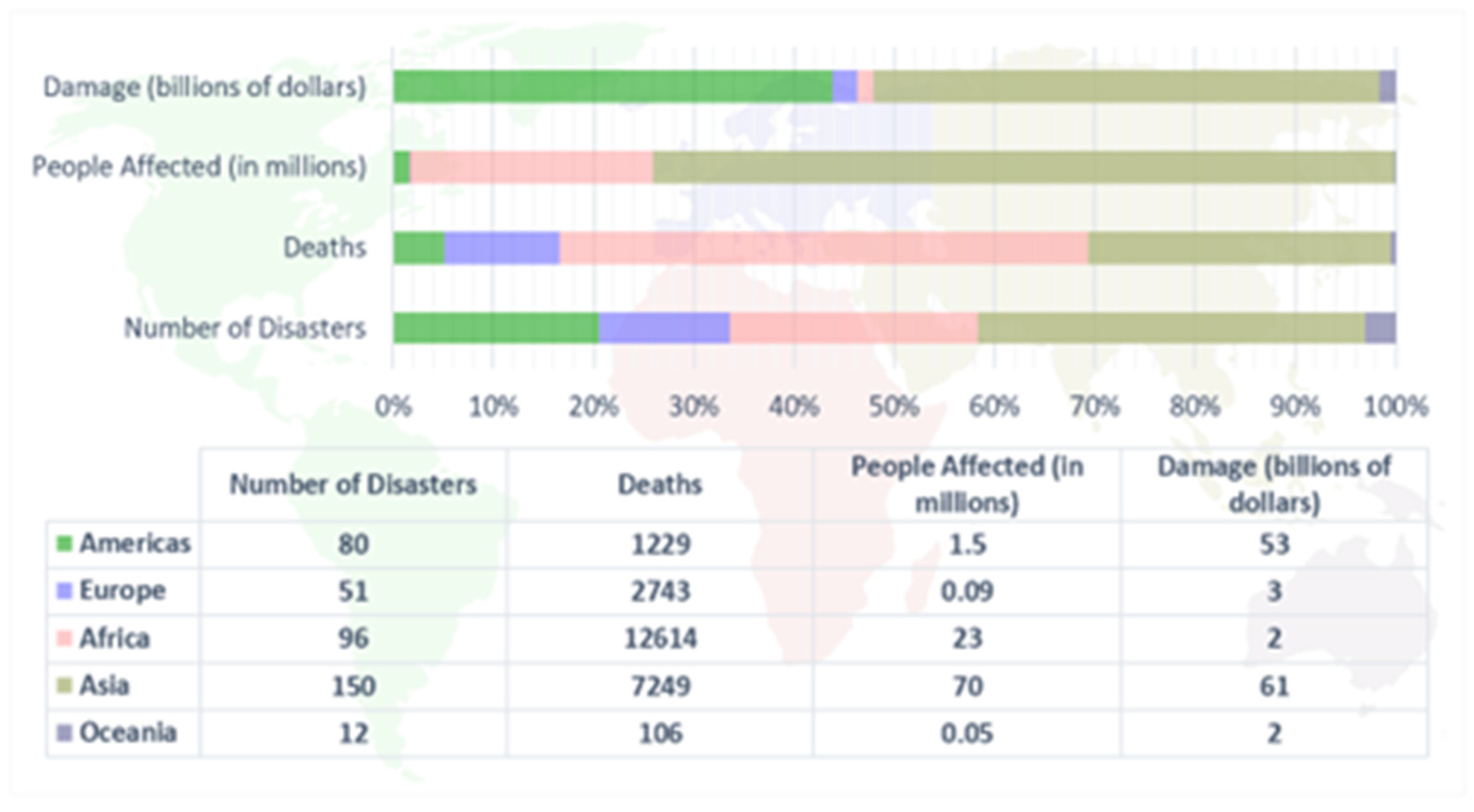
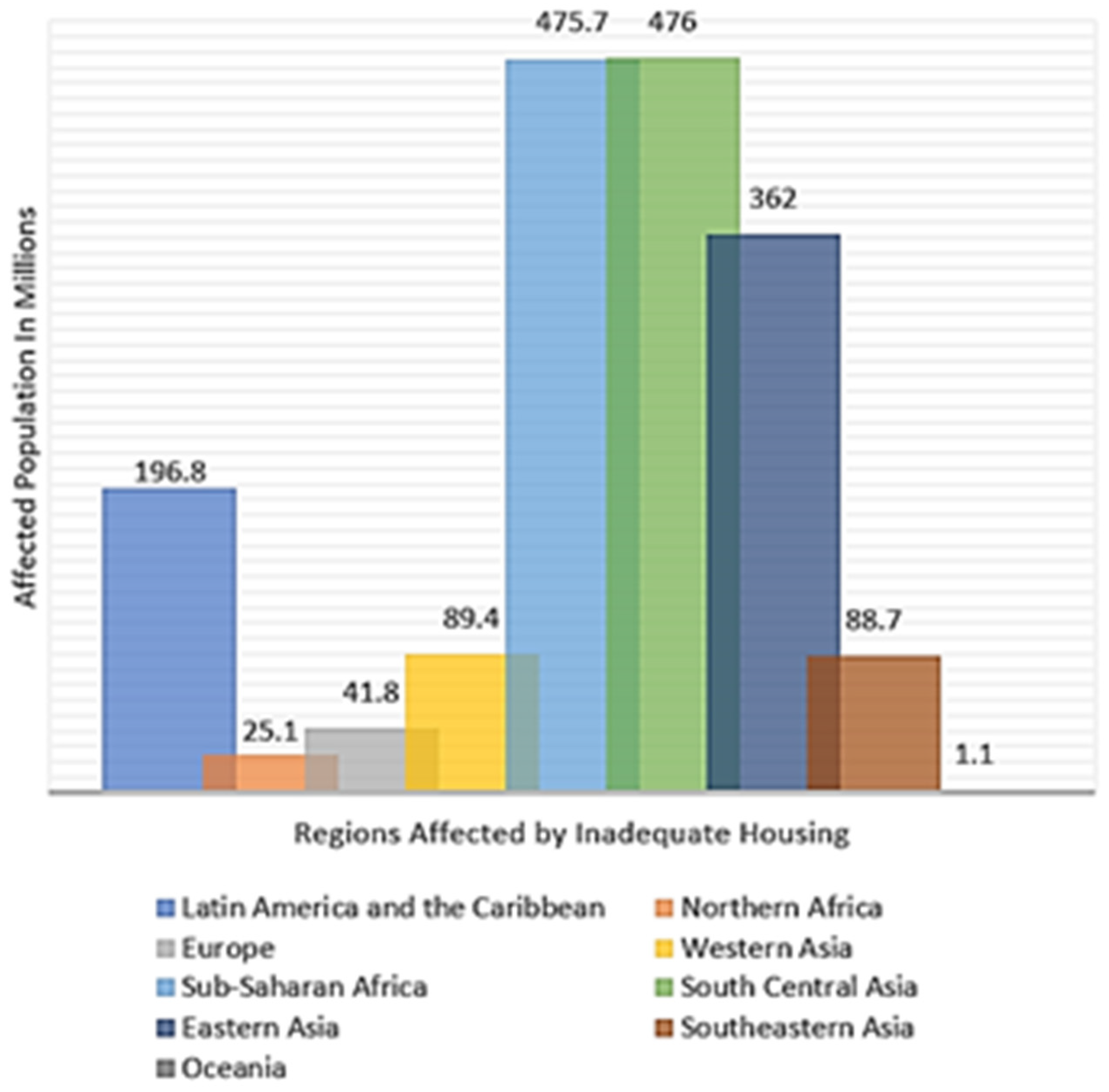

2. The Emergency Housing Process
3. Research Methodology and Materials
3.1. Methodology
3.2. Research Limitations
3.3. Data Collection
4. The Structural-Related Challenges
4.1. The Representative Case Studies
4.2. Codes and Categories: Issues and Challenges
4.2.1. Institutional Sustainability
Structural Standards: Procedures, Tests, and Products
Government Effectiveness: Land Rights
Cadastral Information
4.2.2. Environmental Performances
Resilience to Local Hazard
Existence of Sustainable Housing Research
Carbon Footprint
Imported Technology
4.2.3. Socio-Cultural Adequacy
Local Income Opportunities
Inclusive Housing
4.2.4. Economic Effectiveness
Material Provision Time
Affordability
Macro-Planning of the Camp
5. Theoretical Coding: Results
- Within the Institutional Area
- Within the Environmental Efficiency Area
- 1.
- The usage of imported material, typically steel, could be limited to a few key elements to increase the structural performance of the system, namely stability and serviceability. In best practices that emerged from the case studies, corner half–steel columns [20], and diagonal stiffeners and bracings were employed [63].
- 2.
- To help fight deforestation, suitable roofs could be thought that limit the usage of wood either with local or imported technologies. The design of the elements and their joints may be such to avoid the misplacement of the element and be aware of locally feasible installation techniques. This research field may overlap with architectural engineering research on design for disassembly and recycling.
- 3.
- Research in the field of structural refurbishment could support NGOs in the elaboration of allowable modifications within a certain technology or by providing exemplification of alternative designs based on modular applications which might allow safe modifications to be executed under typical scenarios.
- Within the Economic Effectiveness
- Within the Socio-Cultural Appropriateness
6. Conclusions
Supplementary Materials
Author Contributions
Funding
Data Availability Statement
Conflicts of Interest
References
- Jovanovic, P. Modelling of relationship between natural and man-made hazards. In Natural and Man-Made Hazards; Springer: Dordrecht, The Netherlands, 1988; pp. 9–17. [Google Scholar]
- UN-Habitat. SDG Indicator 11.1.1 Training Module: Adequate Housing and Slum Upgrading; United Nations Human Settlement Programme (UN-Habitat): Nairobi, Kenya, 2018. [Google Scholar]
- Nappi, M.M.L.; Souza, J.C. Temporary shelters: An architectural look at user-environment relationships. Arquitetura Rev. 2017, 13, 112–120. [Google Scholar]
- United Nations Office for Disaster Risk Reduction (UNHCR). Global Assessment Report on Disaster Risk Reduction. Our World at Risk. In Transforming Governance for a Resilient Future; UNHCR: Geneva, Switzerland, 2022. [Google Scholar]
- United Nations Economic Commission for Europe (UNECE). The Geneva UN Charter on Sustainable Housing; (E/ECE/1478/Rev.1); United Nations: New York, NY, USA, 2015. [Google Scholar]
- United Nations Office for Disaster Risk Reduction (UNDRR). Sendai Framework for Disaster Risk Reduction 2015–2030; United Nations: New York, NY, USA, 2015. [Google Scholar]
- Westwater, H. One in Three Adults in Britain “Do Not Have a Safe or Secure Home”. The Big Issue. 2021. Available online: https://www.bigissue.com/news/housing/one-in-three-adults-in-britain-do-not-have-a-safe-or-secure-home/ (accessed on 1 August 2022).
- Grunberg, J.; Eagle, P.F. Shelterization. How the homeless adapt to shelter living. Psychiatr. Serv. 1990, 41, 521–525. [Google Scholar] [CrossRef] [PubMed]
- Sphere Association. The Sphere Handbook: Humanitarian Charter and Minimum Standards in Humanitarian Response, 2018; CHS Alliance, Sphere Association and Groupe URD: Geneva, Switzerland, 2020; Volume 1. [Google Scholar]
- UNICEF; WFP. Return on Investment for Emergency Preparedness Study; United Nations Children’s Fund (UNICEF) and World Food Programme (WFP): New York, NY, USA, 2015. [Google Scholar]
- Gray, B.; Bayley, S. Case Study: Shelter Innovation Ecosystem; CENTRIM, University of Brighton: Brighton, UK, 2015. [Google Scholar]
- International Federation of Red Cross and Red Crescent Societie (IFRC). Shelter Safety Handbook Some Important Information on How to Build Safer; IFRC: Geneva, Switzerland, 2011. [Google Scholar]
- Bello, O.; Bustamante, A.; Pizarro, P. Planning for Disaster Risk Reduction within the Framework of the 2030 Agenda for Sustainable Development; Project Documents (LC/TS.2020/108); Economic Commission for Latin America and the Caribbean (ECLAC): Santiago, Chile; United Nations: New York, NY, USA, 2021. [Google Scholar]
- Jha, A.K. Safer Homes, Stronger Communities: A Handbook for Reconstructing after Natural Disasters; World Bank Publications: Washington, DC, USA, 2011. [Google Scholar]
- Seike, T.; Isobe, T.; Hosaka, Y.; Kim, Y.; Watanabe, S.; Shimura, M. Design and supply system for emergency temporary housing by various construction methods from the perspective of environmental impact assessment. The case for the Great East Japan earthquake. Energy Build. 2019, 203, 109425. [Google Scholar] [CrossRef]
- Bashawri, A.; Garrity, S.; Moodley, K. An overview of the design of disaster relief shelters. Procedia Econ. Financ. 2014, 18, 924–931. [Google Scholar] [CrossRef]
- Alshawawreh, L.; Pomponi, F.; D’Amico, B.; Snaddon, S.; Guthrie, P. Qualifying the sustainability of novel designs and existing solutions for post-disaster and post-conflict sheltering. Sustainability 2020, 12, 890. [Google Scholar] [CrossRef]
- Martins, A.N.; Hobeica, L.; Hobeica, A.; Colacios, R. Lessons for humanitarian architecture from design contests. The case of the Building 4Humanity Design Competition. In Enhancing Disaster Preparedness; Elsevier: Amsterdam, The Netherlands, 2021; Available online: https://linkinghub.elsevier.com/retrieve/pii/B978012819078400006X (accessed on 2 July 2022).
- Ermolli, S.R.; Galluccio, G. Semi-temporary post-earthquake settlements in Italian historical centers. Performance-based guidelines and BIM simulations. In Structures and Architecture. A Viable Urban Perspective? CRC Press: Boca Raton, FL, USA, 2022; pp. 441–448. [Google Scholar]
- Portieles, J.I.R. Techo’s emergency-housing response to hurricanes in Puerto Rico: Lessons from the field. In Enhancing Disaster Preparedness; Martins, A.N., Fayazi, M., Kikano, F., Hobeica, L., Eds.; Elsevier: Amsterdam, The Netherlands, 2021; pp. 23–39. [Google Scholar]
- Andriessen, A.; Paidakaki, A.; Susilo, C.; Van den Broeck, P. Architects’ multifaceted roles in enhancing resilience after disasters. In Enhancing Disaster Preparedness; Martins, A.N., Fayazi, M., Kikano, F., Hobeica, L., Eds.; Elsevier: Amsterdam, The Netherlands, 2021; pp. 129–148. [Google Scholar]
- Pan, W. Innovative methodology for measuring and predicting engineering sustainability. In Proceedings of the Institution of Civil Engineers-Engineering Sustainability; Thomas Telford Ltd.: London, UK, 2022; Volume 175, pp. 111–112. [Google Scholar]
- Moles, O.; Caimi, A.; Islam, M.S.; Hossain, T.R.; Podder, R.K. From local building practices to vulnerability reduction. Building resilience through existing resources, knowledge and know-how. Procedia Econ. Financ. 2014, 18, 932–939. [Google Scholar] [CrossRef]
- Eisenhardt, K.M. Building theories from case study research. Acad. Manag. Rev. 1989, 14, 532–550. [Google Scholar] [CrossRef]
- Eisenhardt, K.M.; Graebner, M.E. Theory building from cases. Opportunities and challenges. Acad. Manag. J. 2007, 50, 25–32. [Google Scholar] [CrossRef]
- Flores, M.C.; Meaney, M.C. Pathways to permanence. A strategy for disaster response and beyond. In Disaster Response Shelter Catalogue; Flores, M.C., Kloer, P., Eds.; Habitat for Humanity International: Atlanta, GA, USA, 2013. [Google Scholar]
- Quarantelli, E.L. Disaster crisis management. A summary of research findings. J. Manag. Stud. 1988, 25, 373–385. [Google Scholar] [CrossRef]
- Quarantelli, E.L. Patterns of sheltering and housing in US disasters. Disaster Prev. Manag. 1995, 4, 43–53. [Google Scholar] [CrossRef]
- Betts, A.; Loescher, G.; Milner, J. The United Nations High Commissioner for Refugees (UNHCR): The Politics and Practice of Refugee Protection; Routledge: London, UK, 2013; Available online: https://www.unhcr.org/refugee-statistics/ (accessed on 2 July 2022).
- European Commission. Humanitarian Shelter and Settlements Guidelines; DG ECHO Thematic Policy Document n° 9 (June); European Commission: Brussels, Belgium, 2017. [Google Scholar]
- George, J.W.; Guthrie, P.; Orr, J.J. Re-defining shelter. Humanitarian sheltering. Disasters 2022. [Google Scholar] [CrossRef] [PubMed]
- Glaser, B.G.; Strauss, A.L. The Discovery of Grounded Theory: Strategies for Qualitative Research; Routledge: London, UK, 2017. [Google Scholar]
- Chun Tie, Y.; Birks, M.; Francis, K. Grounded theory research. A design framework for novice researchers. SAGE Open Med. 2019, 7, 2050312118822927. [Google Scholar] [CrossRef] [PubMed]
- Corbin, J.; Strauss, A. Basics of qualitative research. In Techniques and Procedures for Developing Grounded Theory; Sage Publications: New York, NY, USA, 2014. [Google Scholar]
- Vargas Nasser, A. Development of a Light Weight Structure for Emergency Housing of Refugees. Master’s Thesis, Product Development, Chalmers University of Technology, Gothenburg, Sweden, 2011. [Google Scholar]
- Andersen, B.; Fagerhaug, T. Root cause analysis: Simplified tools and techniques. J. Healthc. Qual. 2002, 24, 46–47. [Google Scholar] [CrossRef]
- Adamec, J.; Janoušková, S.; Hák, T. How to measure sustainable housing. A proposal for an indicator-based assessment tool. Sustainability 2021, 13, 1152. [Google Scholar] [CrossRef]
- Global Shelter Cluster. Shelter Projects Essentials; IFRC: Paris, France; IOM: Grand-Saconnex, Switzerland; UNHCR: Geneva, Switzerland; UN-Habitat: Nairobi, Kenya, 2015; Available online: https://sheltercluster.org/ (accessed on 3 July 2022).
- Global Shelter Cluster. Shelter Projects, 8th ed.; IFRC: Paris, France; IOM: Grand-Saconnex, Switzerland; UNHCR: Geneva, Switzerland; UN-Habitat: Nairobi, Kenya, 2021; Available online: https://sheltercluster.org/ (accessed on 12 July 2022).
- UNICEF; Supply Division; Innovation Unit. UNICEF Target Product Profile Multipurpose Tent 24 m2, 48 m2 and 72 m2, 3rd ed.; United Nations Children’s Fund (UNICEF): New York, NY, USA, 2017; Available online: https://www.unicef.org/supply/ (accessed on 13 July 2022).
- UNICEF; Supply Division. Temporary Structures. Currently Available Products; United Nations Children’s Fund (UNICEF): New York, NY, USA, 2014; 8p, Available online: https://www.unicef.org/supply/ (accessed on 12 July 2022).
- Federal Emergency Management Agency (FEMA). Design Guidance for Shelters and Safe Rooms; Risk Management Series 453; Whole Building Design Guide (WBDG): Washington, DC, USA, 2006; Available online: https://www.wbdg.org/ffc/dhs/criteria/fema-453 (accessed on 15 July 2022).
- Global Shelter Cluster. Shelter Projects. Shelter in Europe. 15 Relevant Case Studies; IFRC: Paris, France; IOM: Grand-Saconnex, Switzerland; UNHCR: Geneva, Switzerland; UN-Habitat: Nairobi, Kenya, 2017; Available online: https://shelterprojects.org (accessed on 25 July 2022).
- Dillon, N.; Campbell, L. ALNAP Lessons Papers: A Methods Note (ALNAP Methods Note); ALNAP/ODI: London, UK, 2018. [Google Scholar]
- UNHCR Technical Support Section Shelter and Sustainability. A Technical and Environmental Comparative Overview of Common Shelter Typologies Found in Settlements across UNHCR Operations; United Nations High Commissioner for Refugees (UNHCR): Geneva, Switzerland, 2021. [Google Scholar]
- International Federation of Red Cross & Red Crescent Societies (IFRC). Post-Disaster Shelter. Ten Designs; IFRC: Geneva, Switzerland, 2013; Available online: https://www.shelterprojects.org/tshelter-8designs/10designs2013/2013-10-28-Post-disaster-shelter-ten-designs-IFRC-lores.pdf (accessed on 20 July 2022).
- International Federation of Red Cross & Red Crescent Societies (IFRC). All-under-One-Roof; IFRC: Geneva, Switzerland, 2015; Available online: https://www.ifrc.org/ (accessed on 18 July 2022).
- UNICEF. Providing Shelter in Times of Crisis; United Nations Children’s Fund (UNICEF). Available online: https://www.unicef.org/supply/stories/providing-shelter-times-crisis (accessed on 20 October 2022).
- McIntosh, J. The implications of post disaster recovery for affordable housing. In Approaches to Disaster Management—Examining the Implications of Hazards, Emergencies and Disasters; Tiefenbacher, J., Ed.; IntechOpen: London, UK, 2013. [Google Scholar] [CrossRef]
- Shelter Cluster Chad. IDP Shelter and Settlements Environmental Impact Report; United Nations High Commissioner for Refugees—UNHCR: Geneva, Switzerland, 2022. [Google Scholar]
- Ingeniøren. Frendesen 4 CM. Dansk Shelter-Opfindelse Giver Flygtninge et Hjem. 2015. Available online: https://ing.dk/artikel/dansk-shelter-opfindelse-giver-flygtninge-et-hjem-178916 (accessed on 20 July 2022).
- Aggernæs, L.U. Fra Projekt til Seriøs Virksomhed: Lifeshelter Rykker Sig Dag for Dag. Erhvervplus. Available online: https://erhvervplus.dk/artikel/fra-projekt-til-seri%C3%B8s-virksomhed-lifeshelter-rykker-sig-dag-for-dag (accessed on 1 August 2022).
- Dezeen. Shigeru Ban Builds Modular Partitions to Offer Privacy to Ukrainians in Emergency Shelters. 2022. Available online: https://www.dezeen.com/2022/04/08/shigeru-ban-paper-partition-system-ukraine-refugee-shelter/ (accessed on 20 July 2022).
- FORTS U.S. A Fold Out Shelters. 2022. Available online: https://fortsusa.com/ (accessed on 8 August 2022).
- United Nations High Commissioner for Refugees (UNHCR). Shelter Design Catalogue; UNHCR: Geneva, Switzerland, 2016; 68p. [Google Scholar]
- Better Shelter. RHU Structur. 2022. Available online: https://bettershelter.org/protracted-crises/ (accessed on 15 July 2022).
- Shah, M.W.; Ali, I.; Khan, A.A. Sustainability in design of emergency shelters. A case study of innovative emergency shelter design for internally displaced persons, Sheikh Shehzad camp, Mardan, Khyber Pakhtunkhwa, Pakistan. Pak. J. Soc. Educ. Lang. (PJSEL) 2020, 6, 208–215. [Google Scholar]
- Global Shelter Cluster. Shelter-Projects-Haiti-2020-Hires. 2020. Available online: http://shelterprojects.org/shelterprojects-compilations/Shelter-Projects-Haiti-2020-Hires.pdf (accessed on 20 August 2022).
- IOM Pakistan. One Room Shelter Program; International Organization for Migration (IOM): Grand-Saconnex, Switzerland, 2019; Available online: https://www.humanitarianlibrary.org/collection/one-room-shelter-program-iom-pakistan (accessed on 20 August 2022).
- Chen, L.; Zhai, C.; Wang, L.; Hu, X.; Huang, X. Modular Structure Construction Progress Scenario: A Case Study of an Emergency Hospital to Address the COVID-19 Pandemic. Sustainability 2022, 14, 11243. [Google Scholar] [CrossRef]
- Iuorio, O.; Russo, M. Future scenarios for housing (re) settlements in Ecuador. Archit. Struct. Constr. 2022, 2, 711–722. [Google Scholar] [CrossRef]
- Florida Solar Energy Center; Thomas-Rees, S. Improved Specifications for Federally Procured Ruggedized Manufactured Homes for Disaster Relief in Hot/Humid Climates; (FSEC-CR-1645-06); FSEC Energy Res Center®: Cocoa, FL, USA, 2006; Available online: https://stars.library.ucf.edu/fsec/492 (accessed on 10 August 2022).
- O’Brien, D.; Carrasco, S. Incremental housing in Villa Verde, Chile: A view through the Sendai Framework lens. In Enhancing Disaster Preparedness; Martins, A.N., Fayazi, M., Kikano, F., Hobeica, L., Eds.; Elsevier: Amsterdam, The Netherlands, 2021; pp. 223–240. Available online: https://www.sciencedirect.com/science/article/pii/B9780128190784000125 (accessed on 1 August 2022).
- United Nations Human Settlements Programme (UN-Habitat). Turkana Houses; (HS/050/20E); United Nations Human Settlements Programme: Nairobi, Kenya, 2020; ISBN 978-92-1-132873-8. Available online: https://unhabitat.org/turkana-houses (accessed on 15 July 2022).
- Rahman, M.A.; Mallick, F.H.; Mondal, M.S.; Rahman, M.R. Flood shelters in Bangladesh: Some issues from the user’s perspective. In Hazards, Risks, and Disasters in Society; Shroder, J.F., Collins, A.E., Jones, S., Manyena, B., Jayawickrama, J., Eds.; Academic Press: Cambridge, MA, USA, 2015; pp. 145–159. Available online: https://www.sciencedirect.com/science/article/pii/B9780123964519000093 (accessed on 13 August 2022).
- Nanda, R.P.; Shrikhande, M.; Agarwal, P. Low-cost base-isolation system for seismic protection of rural buildings. Pract. Period. Struct. Des. Constr. 2016, 21, 04015001. [Google Scholar] [CrossRef]
- Panchal, V.R.; Jangid, R.S. Seismic response of structures with variable friction pendulum system. J. Earthq. Eng. 2009, 13, 193–216. [Google Scholar] [CrossRef]
- Celentano, G.; Escamilla, E.Z.; Göswein, V.; Habert, G. A matter of speed. The impact of material choice in post-disaster reconstruction. Int. J. Disaster Risk Reduct. 2019, 34, 34–44. [Google Scholar] [CrossRef]
- International Organization for Migration (IOM). Transitional Shelter Guidelines; International Organization for Migration (IOM): Grand-Saconnex, Switzerland, 2012; Available online: https://sheltercluster.org/ (accessed on 8 July 2022).
- Kaminski, S.; Lawrence, A.; Trujillo, D. Design Guide for Engineered Bahareque Housing; INBAR–International Network for Bamboo and Rattan: Beijing, China, 2016. [Google Scholar]
- Global Shelter Cluster Indonesia. In Shelter Sub Cluster Timeline 2018–2020. 2020. Available online: https://reliefweb.int/report/indonesia/shelter-sub-cluster-timeline-2018-2020 (accessed on 15 August 2022).
- Caia, G.; Ventimiglia, F.; Maass, A. Container vs. dacha. The psychological effects of temporary housing characteristics on earthquake survivors. J. Environ. Psychol. 2010, 30, 60–66. [Google Scholar] [CrossRef]
- Moles, O.; Crété, E.; Caimi, A.; Gutierrez, E.S.; Ashmore, J.; Nko’o, C.B.; Cauderay, E.; Hosta, J.; Cornet, L.; Mendes, M.F.; et al. Local Building Cultures for Sustainable and Resilient Habitats—Examples of Local Good Practices and Technical Solutions; International Federation of Red Cross and Red Crescent Societies (IFRC): Geneva, Switzerland, 2017. [Google Scholar]
- Post-Disaster Shelter: Ten Designs Presentation. 2013. Available online: https://www.humanitarianlibrary.org/resource/post-disaster-shelter-ten-designs (accessed on 26 November 2022).
- The House That Tateh Built… Out of Sand-Filled Plastic Bottles. 2017. Available online: https://www.theguardian.com/environment/2017/jun/30/house-tateh-built-sand-filled-recycled-waste-plastic-bottles-western-sahara- (accessed on 26 November 2022).
- Core Relief Items Catalogue. 2012. Available online: https://cms.emergency.unhcr.org/documents/11982/45957/Core+Relief+Items+Catalogue/f323c300-83e8-4238-960b-8701fccca5e0 (accessed on 26 November 2022).
- Strategic Recommendations for Shelter Upgrade in Response to the Rohingya Humanitarian Crisis. 2017. Available online: https://www.crs.org/sites/default/files/tools-research/bangladesh-shelter-case-study-rohingya-crisis.pdf (accessed on 26 November 2022).
- COVID-19 Emergency Shelter Provided for Homeless Migrants in Bosnia and Herzegovina. 2020. Available online: https://www.iom.int/news/covid-19-emergency-shelter-provided-homeless-migrants-bosnia-and-herzegovina (accessed on 26 November 2022).
- Burkina Faso 2019–2020/Conflict. 2021. Available online: https:/www.shelterprojects.org/shelterprojects8/ref/A01-burkinafaso180821.pdf (accessed on 26 November 2022).
- Chad 2019–2020/Conflict. 2021. Available online: https://www.shelterprojects.org/shelterprojects8/ref/A02-chad180821.pdf (accessed on 26 November 2022).
- Chad: Shelter and Settlement Environmental Impact Report 2022 (ENG). 2020. Available online: https://sheltercluster.org/chad/documents/chad-shelter-settlement-environmental-impact-report-2022-eng (accessed on 26 November 2022).
- IDP Shelter and Settlements Environmental Impact Report. 2022. Available online: https://sheltercluster.s3.eu-central-1.amazonaws.com/public/docs/SCC%20-%20Environmental%20Impact%20Report%20-%20ENG_2022_1.pdf? (accessed on 26 November 2022).
- Large-Scale Public Venues as Medical Emergency Sites in Disasters: Lessons from COVID-19 and the Use of Fangcang Shelter Hospitals in Wuhan, China. 2020. Available online: https://pesquisa.bvsalud.org/global-literature-on-novel-coronavirus-2019-ncov/resource/fr/covidwho-603209 (accessed on 26 November 2022).
- Shelter Projects East and Horn of Africa: 14 Case Studies. 2018. Available online: https://sheltercluster.s3.eu-central-1.amazonaws.com/public/docs/east_and_horn_of_africa_v1_18june2018.pdf (accessed on 26 November 2022).
- Shelter Safety Handbook: Some Important Information on How to Build Safer. 2020. Available online: https://reliefweb.int/report/world/shelter-safety-handbook-some-important-information-how-build-safer (accessed on 26 November 2022).
- Transitional Shelters: Eight Designs. 2011. Available online: https://www.humanitarianlibrary.org/sites/default/files/2014/02/900300-transitional_shelters-eight_designs-en-lr.pdf (accessed on 26 November 2022).
- Guidance Note: Defining Adequacy of Shelter. 2019. Available online: https://sheltercluster.s3.eu-central-1.amazonaws.com/public/docs/2019.11.17_guidance_note_defining_adequacy_of_shelter_0.pdf (accessed on 26 November 2022).
- L’Aquila C.A.S.E. Project, Emergency Houses. 2009. Available online: https://www.swsglobal.com/projects/c-a-s-e-project-emergency-homes/ (accessed on 26 November 2022).
- Looking beyond the Emergency. 2018. Available online: https://www.abitare.it/en/architecture/projects/2018/07/20/emergency-housing-best-practices/ (accessed on 26 November 2022).
- Prefabs for Immediate Disaster Relief. 2018. Available online: https://www.gov-online.go.jp/eng/publicity/book/hlj/html/201803/201803_05_en.html (accessed on 26 November 2022).
- Shelter Projects Shelter in the Middle East: 16 Case Studies. 2019. Available online: http://shelterprojects.org/shelterprojects-compilations/Shelter-Projects-Middle-East-July2019.pdf (accessed on 26 November 2022).
- Temporary Shelter Research Report. 2018. Available online: https://recovery.preventionweb.net/publication/temporary-shelter-research-report (accessed on 26 November 2022).
- Shelter Design Catalogue. 2016. Available online: https://cms.emergency.unhcr.org/documents/11982/57181/Shelter+Design+Catalogue+January+2016/a891fdb2-4ef9-42d9-bf0f-c12002b3652e (accessed on 26 November 2022).
- Maanasa, V.L.; Reddy, S.L. Origami-Innovative Structural Forms & Applications in Disaster Management. Int. J. Curr. Eng. Technol. 2014, 4, 3431–3436. Available online: https://inpressco.com/wp-content/uploads/2014/10/Paper643431-3436.pdf (accessed on 26 November 2022).
- Fordyce, S. Survival Architecture and the Art of Resilience. Des. Cult. 2020, 12, 360–364. [Google Scholar] [CrossRef]
- 35 Pound Foldable Compact Shelter Provides Lightweight Disaster Housing in under Two Minutes. 2014. Available online: https://inhabitat.com/35-pound-foldable-compact-shelter-provides-lightweight-disaster-housing-in-under-two-minutes/alastair-pryors-pop-up-emergency-homes/ (accessed on 26 November 2022).
- Chapter 2—Techo’s Emergency-Housing Response to Hurricanes in Puerto Rico: Lessons from the Field. 2021. Available online: https://www.sciencedirect.com/science/article/pii/B9780128190784000022 (accessed on 26 November 2022).
- Mounaim, A.; Priyomarsono, N.W.; Trisno, R. Emergency Shelter Design For Disaster Preparation. IOP Conf. Ser. Mater. Sci. Eng. 2020, 852, 012152. [Google Scholar] [CrossRef]
- Melancon, D.; Gorissen, B.; García-Mora, C.J.; Hoberman, C.; Bertoldi, K. Multistable inflatable origami structures at the metre scale. Nature 2021, 592, 545–550. [Google Scholar] [CrossRef]
- Multistable Inflatable Origami Structures at the Metre Scale. 2020. Available online: https://bertoldi.seas.harvard.edu/files/bertoldi/files/nature_david.pdf (accessed on 26 November 2022).
- NASA Works with U.S. Forest Service to Improve Fire Shelters. 2016. Available online: https://www.nasa.gov/feature/langley/nasa-works-with-us-forest-service-to-improve-fire-shelters (accessed on 26 November 2022).
- Mesrop, A. Algorithmic design and evaluation of emergency shelters. Archit. Eng. Des. Manag. 2021, 17, 229–241. [Google Scholar] [CrossRef]
- Sebastian og Karl Byggede Månebolig og Levede 60 Dage på 4½ m2. 2022. Available online: https://www.tv2lorry.dk/oplev/sebastian-og-karl-byggede-maanebolig-og-levede-60-dage-paa-4-m2 (accessed on 26 November 2022).
- Emergency Architecture. Modular Construction of Healthcare Facilities as a Response to Pandemic Outbreak. 2021. Available online: https://www.e3s-conferences.org/articles/e3sconf/pdf/2021/50/e3sconf_stcce2021_01013.pdf (accessed on 26 November 2022).
- Mark, E.; Cheng, N.; Golczewski, D.; Chen, I.; Zad, M. A min-max protocol for adaptive refugee housing. In Structures and Architecture. A Viable Urban Perspective?: Proceedings of the Fifth International Conference on Structures and Architecture (ICSA 2022), Aalborg, Denmark, 6–8 July 2022; CRC Press: Boca Raton, FL, USA, 2022; p. 449. [Google Scholar] [CrossRef]
- Bennesved, P. Sheltered Society: Civilian Air Raid Shelters in Sweden—From Idea to Materiality, 1918–1940 and beyond. Doctoral Dissertation, Universus Academic Press, Lund, Sweden, 2020. Available online: https://portal.research.lu.se/en/activities/peter-bennesved-sheltered-society-civilian-air-raid-shelters-in-s (accessed on 26 November 2022).
- Shelter Projects 8th Edition: The Eighth Book in the Shelter Projects Series of Case Study Compilations. 2022. Available online: http://www.shelterprojects.org/editions.html#8thedition (accessed on 26 November 2022).
- Temporary Buildings and Structures. 2022. Available online: https://www.temporarystructures.co.uk/covid19/emergency-cover/ (accessed on 26 November 2022).
- Celina: Government and Military. 2022. Available online: https://celinamilitaryshelters.com/ (accessed on 26 November 2022).
- Lichtman, S.A. Do-It-Yourself Security: Safety, Gender, and the Home Fallout Shelter in Cold War America. J. Des. Hist. 2006, 19, 39–55. [Google Scholar] [CrossRef][Green Version]
- The Implications of Post Disaster Recovery for Affordable Housing. 2013. Available online: https://www.intechopen.com/chapters/44228#F1 (accessed on 26 November 2022).
- Rapid Response Disaster Relief. 2022. Available online: https://fortsusa.com/models/emergency/disaster-relief/ (accessed on 26 November 2022).
- Shelter Projects 8th Edition Launch. 2021. Available online: https://sheltercluster.org/shelter-projects-working-group/events/shelter-projects-8th-edition-launch (accessed on 26 November 2022).
- Augmented Reality of the High Performance Tents. 2022. Available online: https://www.unicef.org/innovation/xr/highperformancetents (accessed on 26 November 2022).
- Refugee Housing Unit—RHU. 2022. Available online: https://cms.emergency.unhcr.org/documents/11982/57181/Refugee+Housing+Unit+Fact+Sheet/7b4fce59-0af2-45ea-9386-7fde249d2fe9 (accessed on 26 November 2022).
- New Self-Standing Family Tent. 2022. Available online: https://cms.emergency.unhcr.org/documents/11982/57181/New+Self+Standing+Tent/0bf6fa33-248a-46d6-94de-4ff893772045 (accessed on 26 November 2022).
- The Humanitarian Works of Shigeru Ban. 2020. Available online: https://www.archdaily.com/489255/the-humanitarian-works-of-shigeru-ban (accessed on 26 November 2022).
- Create Structure: Our Story. 2022. Available online: https://www.create-structure.org/ourstory (accessed on 26 November 2022).
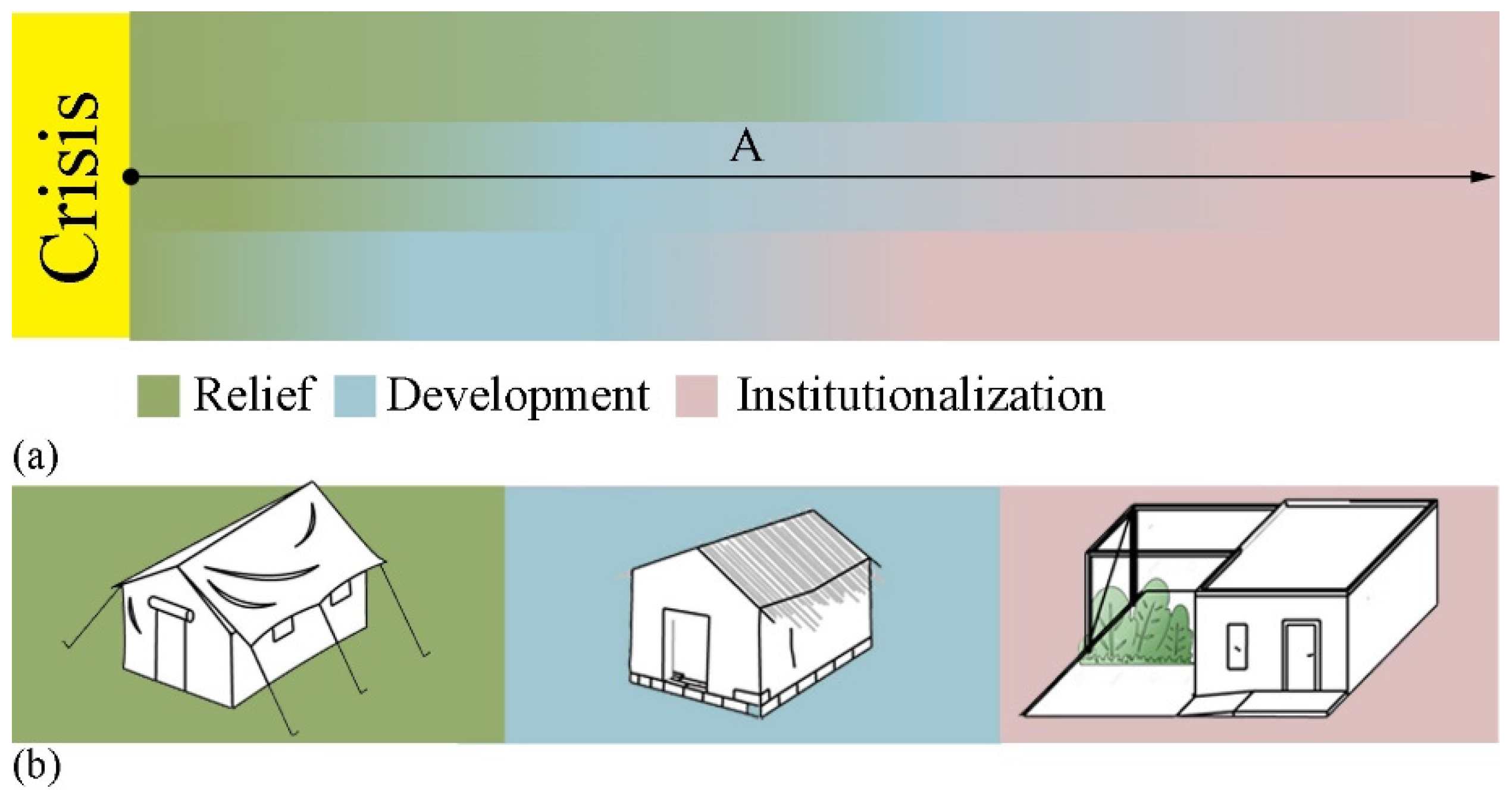



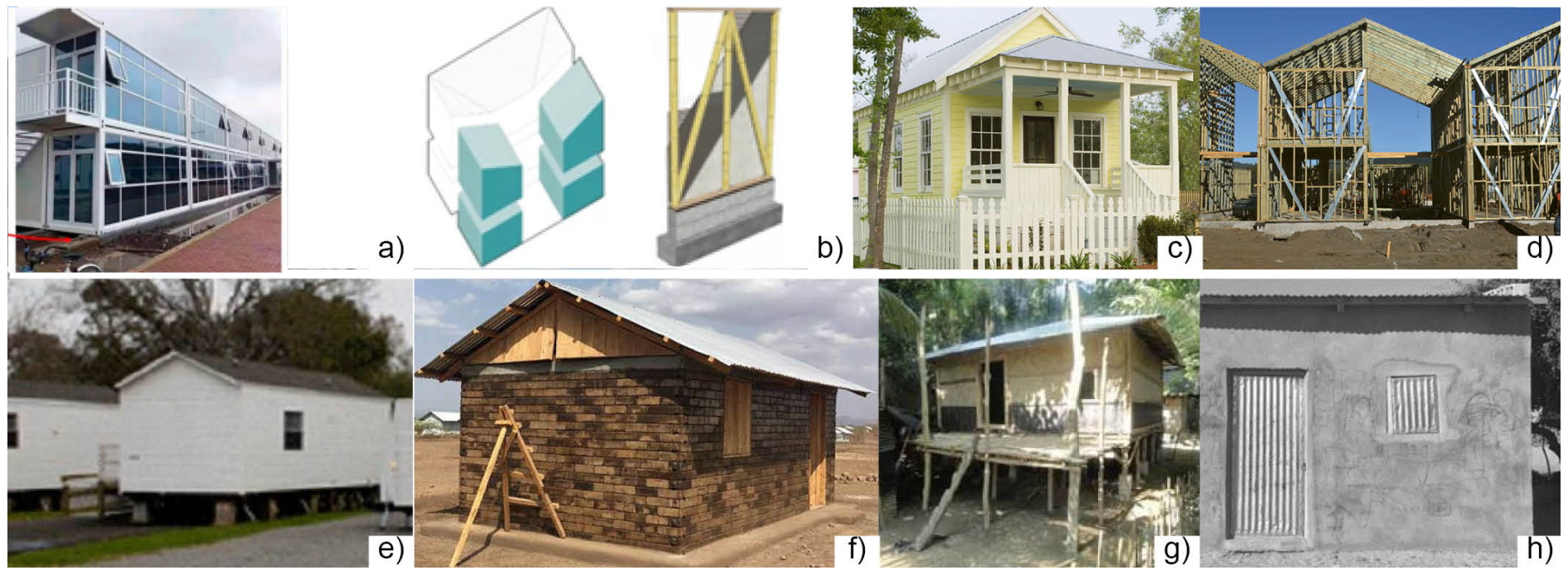
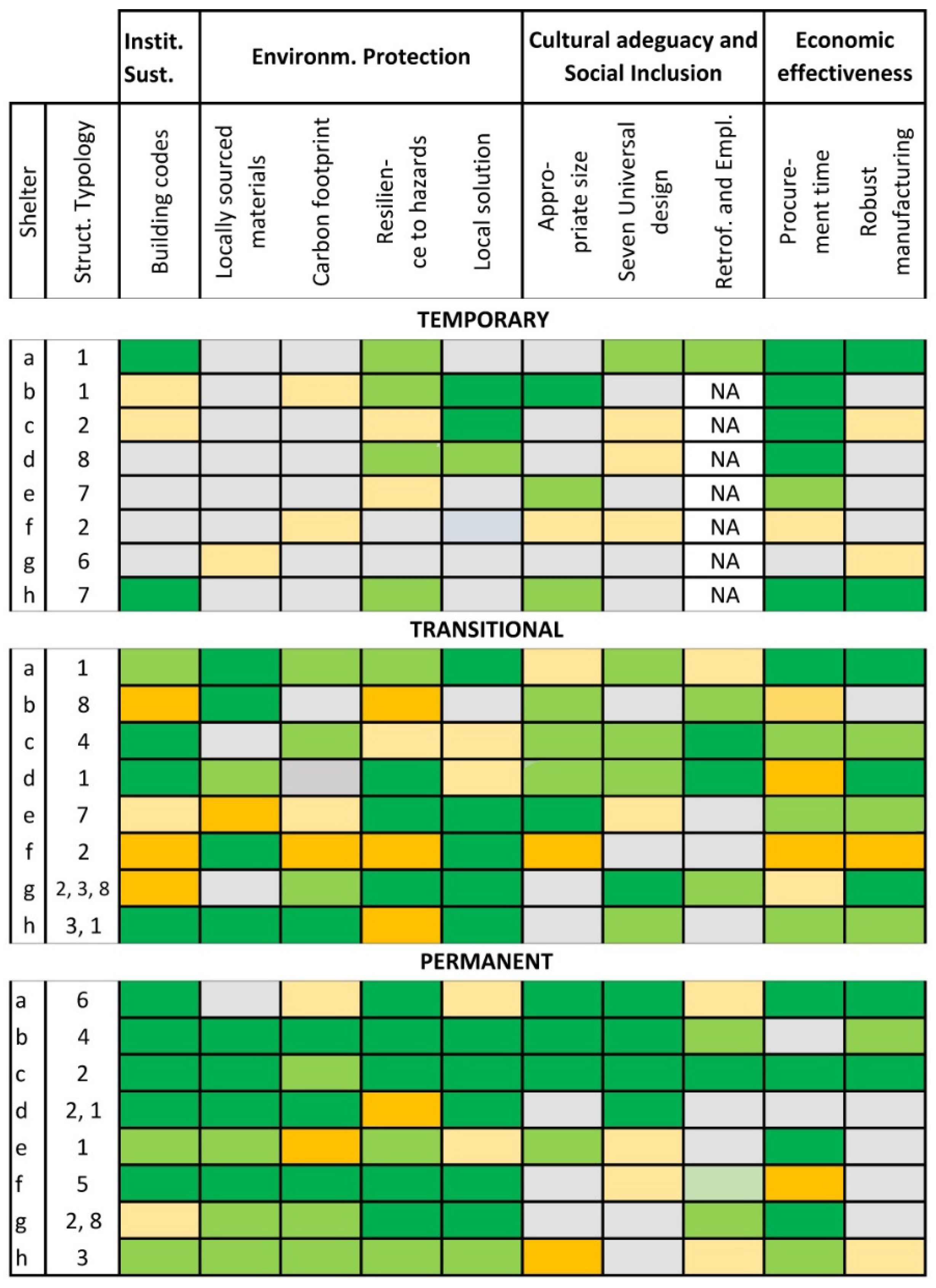
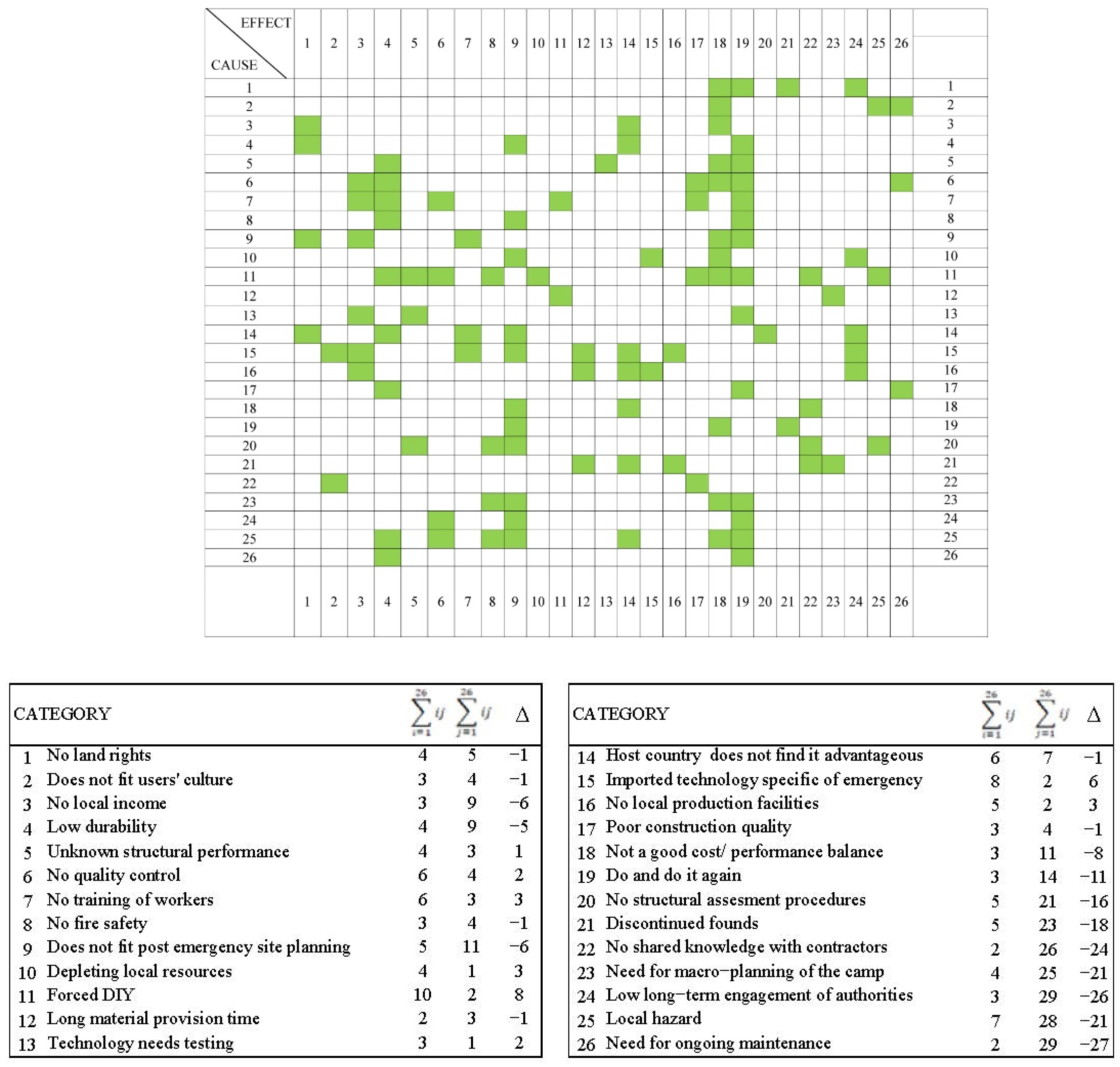
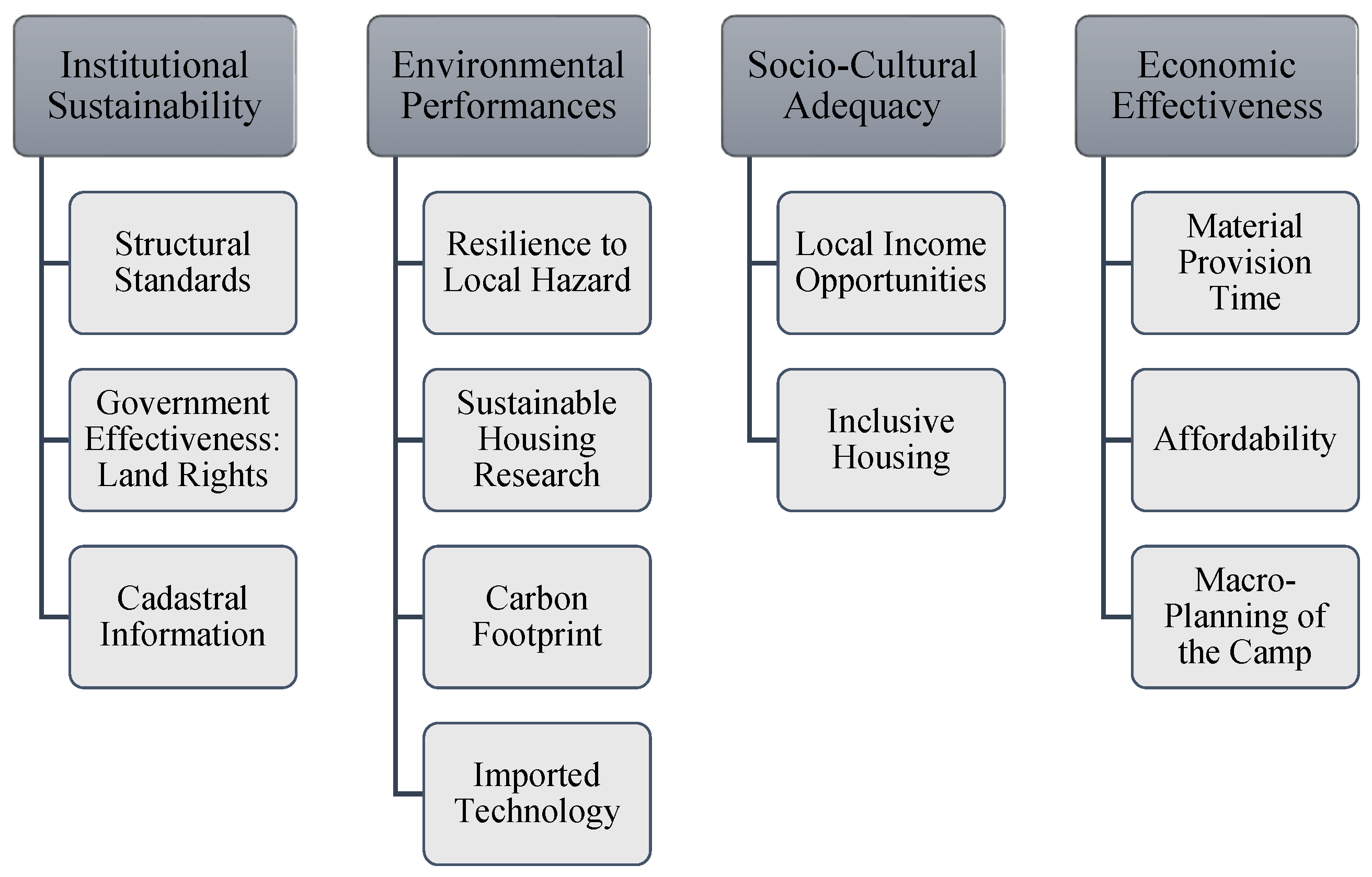

Disclaimer/Publisher’s Note: The statements, opinions and data contained in all publications are solely those of the individual author(s) and contributor(s) and not of MDPI and/or the editor(s). MDPI and/or the editor(s) disclaim responsibility for any injury to people or property resulting from any ideas, methods, instructions or products referred to in the content. |
© 2022 by the authors. Licensee MDPI, Basel, Switzerland. This article is an open access article distributed under the terms and conditions of the Creative Commons Attribution (CC BY) license (https://creativecommons.org/licenses/by/4.0/).
Share and Cite
Beatini, V.; Rajanayagam, H.; Poologanathan, K. Structural and Spatial Minimal Requirement Efficacy of Emergency Shelters for Different Emergencies. Buildings 2023, 13, 32. https://doi.org/10.3390/buildings13010032
Beatini V, Rajanayagam H, Poologanathan K. Structural and Spatial Minimal Requirement Efficacy of Emergency Shelters for Different Emergencies. Buildings. 2023; 13(1):32. https://doi.org/10.3390/buildings13010032
Chicago/Turabian StyleBeatini, Valentina, Heshachanaa Rajanayagam, and Keerthan Poologanathan. 2023. "Structural and Spatial Minimal Requirement Efficacy of Emergency Shelters for Different Emergencies" Buildings 13, no. 1: 32. https://doi.org/10.3390/buildings13010032
APA StyleBeatini, V., Rajanayagam, H., & Poologanathan, K. (2023). Structural and Spatial Minimal Requirement Efficacy of Emergency Shelters for Different Emergencies. Buildings, 13(1), 32. https://doi.org/10.3390/buildings13010032






